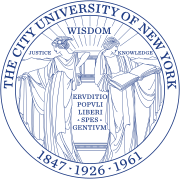
Back جامعة مدينة نيويورك Arabic نیویورک سیتی بیلیمیوردو AZB Нью-Ёркскі гарадскі ўніверсітэт Byelorussian Universitat de la Ciutat de Nova York Catalan City University of New York German Urba Universitato de Novjorko Esperanto Universidad Municipal de Nueva York Spanish City University of New York Estonian New York Hiriko Unibertsitatea Basque دانشگاه شهری نیویورک Persian
 | |
| Motto | Latin: Eruditio populi liberi spes gentium |
|---|---|
Motto in English | The education of free people is the hope of Mankind[1] |
| Type | Public university system |
| Established | 1961[2] |
| Budget | $3.6 billion[3] |
| Chancellor | Félix V. Matos Rodríguez[4] |
| Provost | Wendy Hensel |
Academic staff | 19,568[5] |
Administrative staff | 33,099[5] |
| Students | 243,000[6] |
| Location | New York City, New York, U.S. |
| Campus | 25 campuses[7] |
| Website | cuny |
 | |
The City University of New York (CUNY, pronounced /ˈkjuːni/, KYOO-nee) is the public university system of New York City. It is the largest urban university system in the United States, comprising 25 campuses: eleven senior colleges, seven community colleges, and seven professional institutions. The university enrolls more than 275,000 students and counts thirteen Nobel Prize winners and twenty-four MacArthur Fellows among its alumni.[8]
The oldest constituent college of CUNY, City College of New York, was originally founded in 1847 and became the first free public institution of higher learning in the United States.[9] In 1960, John R. Everett became the first chancellor of the Municipal College System of New York City, later known as the City University of New York (CUNY). CUNY, established by New York state legislation in 1961 and signed into law by governor Nelson Rockefeller, was an amalgamation of existing institutions and a new graduate school.
The system was governed by the Board of Higher Education of the City of New York, created in 1926, and later renamed the Board of Trustees of CUNY in 1979. The institutions merged into CUNY included the Free Academy (later City College of New York), the Female Normal and High School (later Hunter College), Brooklyn College, and Queens College. CUNY has historically provided accessible education, especially to those excluded or unable to afford private universities. The first community college in New York City was established in 1955 with shared funding between the state and the city, but unlike the senior colleges, community college students had to pay tuition.
The integration of CUNY's colleges into a single university system took place in 1961, under a chancellor and with state funding. The Graduate Center, serving as the principal doctorate-granting institution, was also established that year. In 1964, Mayor Robert F. Wagner Jr. extended the senior colleges' free tuition policy to community colleges. The 1960s saw student protests demanding more racial diversity and academic representation in CUNY, leading to the establishment of Medgar Evers College and the implementation of the Open Admissions policy in 1970. This policy dramatically increased student diversity but also introduced challenges like low retention rates. The 1976 fiscal crisis ended the free tuition policy, leading to the introduction of tuition fees for all CUNY colleges.
- ^ "History of the Board". City University of New York. Retrieved March 19, 2018.
- ^ The forerunner of today's City University of New York was founded in 1847, but the actual system was established in 1961.
- ^ "University Budget Office Budget & Finance – CUNY". Cuny.edu. Retrieved June 9, 2020.
- ^ "CUNY Appoints Its First Minority Chancellor". NBC New York. Retrieved May 1, 2019.
- ^ a b "Staff Facts Fall 2019" (PDF). cuny.edu.
- ^ "About – The City University of New York". 2.cuny.edu. Retrieved September 15, 2023.
- ^ "Colleges & Schools – The City University of New York". 2.cuny.edu. Retrieved October 1, 2019.
- ^ "Appointment of Interim President". gc.cuny.edu. Retrieved November 1, 2018.
- ^ "... the founding, in 1847, of the Free Academy, the very first free public institution of higher education in the nation.", Baruch College history website. [1] Archived July 25, 2006, at the Wayback Machine